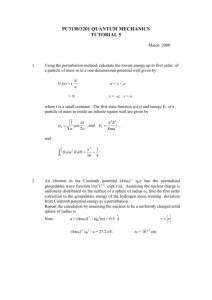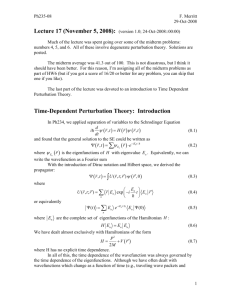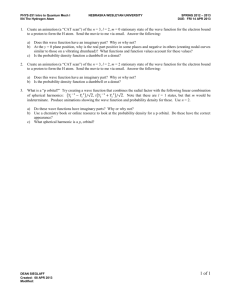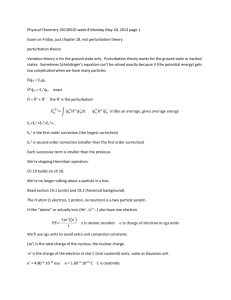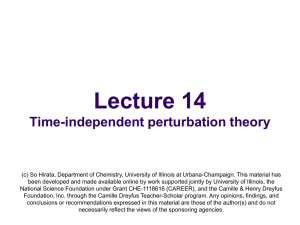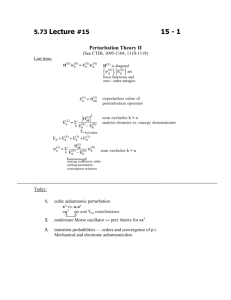A hydrogen atom in weak electric and magnetic fields
advertisement
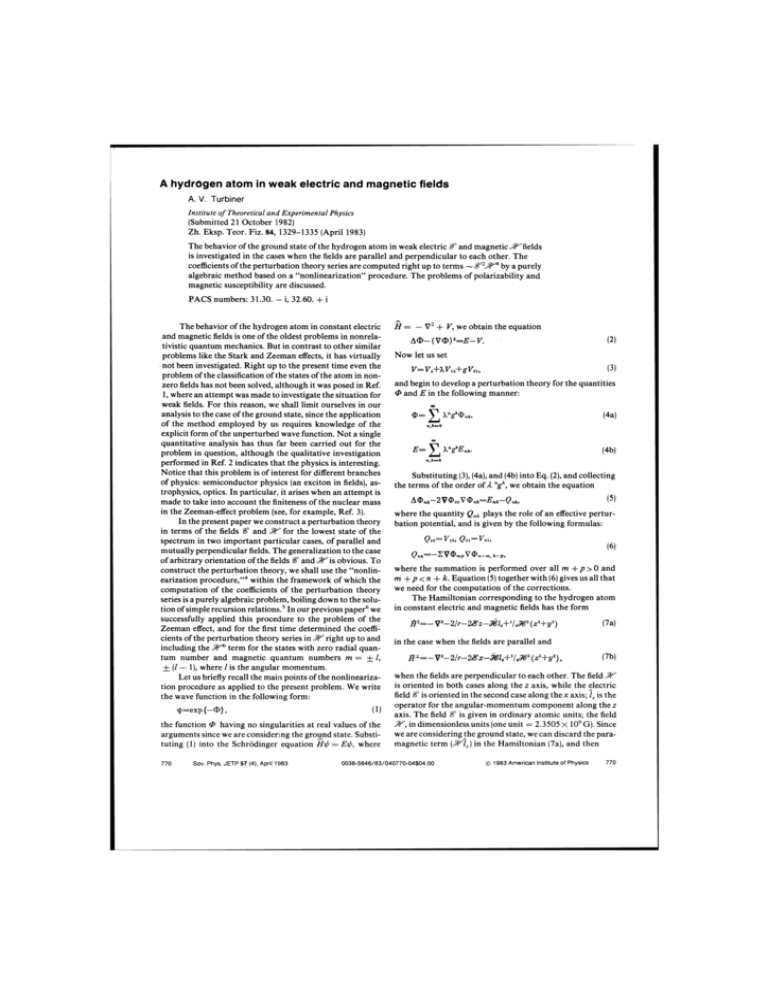
A hydrogen atom in weak electric and magnetic fields
A. V. Turbiner
Institute of Theoretical and Experimental Physics
(Submitted 2 1 October :1982)
Zh. Eksp. Teor. Fiz. 84, 1329-1335 (April 1983)
The behavior of the ground state of the hydrogen atom in weak electric g and magneticpfields
is investigated in the cases when the fields are parallel and perpendicular to each other. The
coefficients of the perturbation theory series are computed right up to terms g 2 pby a purely
algebraic method based on a "nonlinearization" procedure. The problems of polarizability and
magnetic susceptibility ;are discussed.
-
PACS numbers: 31.30. .- i, 32.60. + i
The behavior of the hydrogen atom in constant electric
and magnetic fields is one of the: oldest problems in nonrelativistic quantum mechanics. But in contrast to other similar
problems like the Stark and Zeeman effects, it has virtually
'not been investigated. Right up to the present time even the
problem of the classification of 1he states of the atom in nonzero fields has not been solved, illthough it was posed in Ref.
1, where an attempt was made to investigate the situation for
weak fields. For this reason, we shall limit ourselves in our
analysis to the case of the ground state, since the application
of the method employed by us requires knowledge of the
explicit form of the unperturbed wave function. Not a single
quantitative analysis has thus far been carried out for the
problem in question, although 'the qualitative investigation
performed in Ref. 2 indicates that the physics is interesting.
Notice that this problem is of interest for different branches
of physics: semiconductor physics (an exciton in fields), astrophysics, optics. In particular., it arises when an attempt is
made to take into account the finiteness of the nuclear mass
in the Zeeman-effect problem (see, for example, Ref. 3).
In the present paper we construct a perturbation theory
in terms of the fields 8? and &' for the lowest state of the
spectrum in two important particular cases, of parallel and
mutually perpendicular fields. The generalization to the case
of arbitrary orientation of the fields i
F and R i s obvious. To
construct the perturbation theory, we shall use the "nonlinearization procedure,"4 within the framework of which the
computation of the coefficients of the perturbation theory
series is a purely algebraic proble:m, boiling down to the soluIn our previous paper6 we
tion of simple recursion relation~i.~
successfully applied this procetlure to the problem of the
Zeeman effect, and for the first time determined the coefficients of the perturbation theory series in 2Y right up to and
including the
term for the states with zero radial quantum number and magnetic quantum numbers m = + I,
f (I - l), where I is the angular momentum.
Let us briefly recall the main points of the nonlinearization procedure as applied to the present problem. We write
the wave function in the following form:
the function @ having no singularities at real values of the
arguments since we are consider~~ng
the g r o ~ n dstate. Substituting (1) into the Schrodinger equation H 3 = EJ1, where
770
Sov. Phys. JETP 57 (4), April 1983
h
H=
- V2
+ V, we obtain the equation
A - (VQ)E - V .
Now let us set
and begin to develop a perturbation theory for the quantities
@ and E in the following manner:
Substituting (3),(4a),and (4b)into Eq. (2),and collecting
the terms of the order of A "gk,we obtain the equation
where the quantity Qn,plays the role of an effective perturbation potential, and is given by the following formulas:
where the summation is performed over all m + p > 0 and
m + p < n + k. Equation (5)together with (6)gives us all that
we need for the computation of the corrections.
The Hamiltonian corresponding to the hydrogen atom
in constant electric and magnetic fields has the form
PI=-
~ ~ 2 / r - 2 8 z - & l , + ~( zl Z
~+
y~Z~)
in the case when the fields are parallel and
when the fields are perpendicular to each other. The field X
is oriented in both cases along the z axis, while the electric
field $ is oriented in the second case along thex axis; I, is the
operator for the angular-momentum component along the z
axis. The field is given in ordinary atomic units; the field
Z,
in dimensionless units (one unit = 2.3505 X lo9 G ) .Since
we are consideringfhe ground state, we can discard the paramagnetic term ( X I z )in the Hamiltonian (7a),and then
0038-5646/83/040770-04$04.00
@ 1983 American Institute of Physics
770
r2
Votll=-(Y2°-Yo0), (8a)
6
while in the case of mutually perpendicular fields
T.',O1'=-2z=-2rY,O(0, cp),
There is also a paramagnetic term (iXd/dp ), since the angular momentum component along the z axis is no longer an
integral of the motion"; r, 6, and p are spherical coordinates
and
cos mcp, m>O
Y,"=P," (cos 0)
sinlmlcp, m<O
I
are spherical harmonics.
Let us first consider the simpler case of parallel fields.
Analyzing Eq. (5),we easily see that an arbitrary correction
to the wave function @ !, contains a finite number of harmonics, and has the following form:
where [n + k/4] denotes the integer part of the number
(n + k /4). If k is an odd number, then
Let us represent the expansion for the energy in the
form
E=Esz+EII(L',
(12)
where the term E,, is the sum of the energy expansions in the
case of the Stark- and Zeeman-effect problems:
while E li contains the cross-in the fields-terms:
Notice that the cross terms in (14)were not known before."
Let us now proceed to consider the caseAofmutually
in the Haperpendicular fields. If we neglect the term (XIL)
miltonian (7b), then the perturbation theory can be constructed in a manner entirely similar to the case of parallel
fields. Let us give only the final results for the cross terms:
and note that the structure of the arbitrary correction
resembles that of @ !,:
8 k,
The coefficient functions are polynomials in r, i.e.,
n
II
-
i
( 1=
aJm,
and let us draw attention to the fact that the polynomial
attached to the highest harmonic Y 11 (8,p ) contains only
two terms; the polynomial attached to the next highest har(6,p ) four terms; etc. We shall not write out
monic Y I:
the recursion formulas; they are fairly simple, and can easily
be derived by the reader. We need only note that some of
them can be resolved explicitly in the case of an arbitrary
correction. For example, the coefficient function of the highest harmonic is
+
+
,
,-,
For n = 0, i.e., for $ = 0 (the Zeeman effect),the expression
(I 1) coincides with the expression obtained in Ref. 6, while
fork = 0, i.e., for 3'= 0, the formula (11)goes-overinto the
expression corresponding to the Stark effect. We can, in
principle, find the coefficient function of next highest harmonic, etc., but the calculation becomes more and more
complicated.
The determination of the first corrections offers no fundamental difficulties, but is rather tedious. Therefore, the
computations were performed with the aid of the symbolic
language REDUCE-2. The results for several first corrections to the wave function are given in the Appendix.
771
Sov. Phys. JETP 57 (4), April 1983
where &A, -0 when k is odd. The coefficient functions are
polynomials, and resemble the @ !,in structure: there are
two terms in each of those attached to the highest harmonics
Y ;
~ " ( 6 , p); four in each of those attached to the next highest harmonics, etc. The degrees of the polynomials are the
same as in @ j, .
The situation is s o ~ e w h adifferent
t
in the case when the
is taken into consideration. First,
paramagnetic term (ZIz)
Eq. (5)gets modified, and it assumes the following form:
the Q,, being given as before by the formula (6).Second, the
structure of the correction @ A, to the wave function is significantly more complicated: they have the same fundamental form and are given by the formula (16)in the case of even
k, but do not vanish and are pure imaginary in the case of odd
k;
where k is an odd number. The coefficient functions are
polynomials having the same structure as the R li (see(10))in
the case of even k, and
A. V. Turbiner
771
in the case of odd k. Notice tlnat, in the case of odd k, the
polynomial attached to the highest harmonics
y - n + Z-m (8,p ) contains three terms; that attached to the
next highest harmonics Y ,-,",$2:(8,p
) five terms, etc. As in
the case of parallel fields, the coefficient functions attached
to the highest harmonics can be found explicitly, but we shall
not give their explicit form: the formulas are similar to (11).
As in the case of parallel fields, to find the first corrections, we used the symbolic language REDUCE-2. The expressions for the corrections @ I, are given in the Appendix.
Let us represent the expalision for the energy in a form
similar to (12),and give the final result for the cross terms:
+
,,
It can be seen from a cpmparison of (20)with (15)that
allowance for the term (XIz)
in the Hamiltonian decreases
the coefficients of g 2 p(by 34%)and of g22? (by 40%).
Notice also the quite large values of the coefficients of the
cross terms in (14)and (20),wliich is important for various
investigations within the framework of perturbation theory,
since the region of applicability of the theory shrinks sharply. Also worthy of note is the fact that the coefficients attached to the cross terms in the case of mutually perpendicular fields are consistently mucln greater than in the case of
parallel fields.
CONCLUSION
Thus, we have succeedecl in computing, for the first
time ever, the coefficients attached to the cross terms in the
problem of the hydrogen atom in constant electric and magnetic fields. This became possilble as a result of the application of the "nonlinearization" method, since it is difficult to
conceive such calculations within the framework of the standard approach with the use of sums over intermediate states
or Green functions. Within the framework of the method
used, all the calculations reduce to the solution of simple
recursion relations.
Let us discuss the physical meaning of the results obtained. To begin with, let us note that, since we are working
within the framework of perturbation theory, the region of
applicability of the results obtsdned is limited to the case of
fairly low # and % fields. This is due to the fact that the
series in powers of Z for fixed Z? has a zero convergence
radius, and its coefficients increase in a factorial fashion.
The series in powers of %' for fixed Z has a convergence zero
radius with factorial growth of the coefficients in the case of
parallel fields and a finite radius,of convergence in the case of
perpendicular field^.^' This circumstance is easy to understand when expressed in terms of Dyson's a r g ~ m e n t ,and
~'
we shall not discuss it in detail here. We only note that the
atom is unstable in the case of parallel fields, although the
probability for tunneling is exponentially small (in fairly
weak fields). Let us now fix the electric-field strenght 59, and
write down the expression for the magnetic susceptibility of
the atom:
772
Sov. Phys. JETP 57 (4), April 1983
It can be seen that the standard term -Ptries to
decrease the magnitude of the susceptibility and make the
atom less "diamagnetic," whereas the term g2(which originates from a cross term in the energy) increases the susceptibility, thus stabilizing the situation. This effect is more
strongly pronounced in the case of perpendicular fields.
Let us now consider a different aspect of the problem:
let us fix the magnitude of Z ,and write down the expression
for the polarizability of the atom:
-
If now we take a sufficiently weak field 8 , so that we
can neglect the term g 2 , then it is evident that the term
-A@ decreases effectively the polarizability of the hydrogen atom. Notice that, as in the preceding case, the effect
manifests itself more strongly in the case of perpendicular
fields. It is also worth while to emphasize that in fields of
'
( $ d m , in the case
sufficiently high intensities 8 and 2
when they are related in a certain fashion, there occurs an
effect, first observed by Burkova et al.,' whereby it is advantageous for the electron to be localized in some region of
space away from the proton. From the physical point of view
this is due to the appearance of a second well that under
certain conditions can become effectively deeper than the
Coulomb well. Thus, the atom acquires a large "stable" dipole moment.
In conclusion, let us briefly discuss the case in which the
angle between the directions of the electric and magne+tic
fields is equal to a. Let us assume as before that the field Z is
oriented alon& the z axis, and let us choose the x axis such
that the field g>es in thex-z plane. Then the components of
the vector 59 are equal to #, = g,,= g cosa,
8, =g, = 59 sin a , and #, = 0. It is easy to show that the
energy E will be a function of only gi and g:, as well as of
p.Hence it is clear that nontrivial dependences on the
angle a occur in the perturbation-theory-series terms that
are of higher order than those considered above, e.g., in the
etc., with the possible exception of the
terms 921
term 29; 59,, whose coefficient is clearly equal to - 3555/
16.
In conclusion I wish to thank K. G . Boreskov, E. A.
Solov'ev and K. A. Ter-Martirosyan for useful discussions.
-
::*,
APPENDIX
Here we give a few first corrections to the wave function
in the cases when the fields are parallel or perpendicular to
each other. Their explicit form may turn out to be useful in
different investigations performed within the framework of
perturbation theory for the case of weak fields, as well as in
A. V. Turbiner
772
the construction of variational trial functions that are reasonable from the point of view of the "Dyson argument" (see
the discussion in Ref. 4).
Thus, the expansion of the ground-state wave function
is taken in the form
('4.1)
and the corrections are given by the following expressions
out that each correction to the wave function in the standard
perturbation theory is a sum of a finite number of harmonics
with coefficient functions that are finite polynomials in rand
have the Coulomb wave function as a common factor. If now
we recall the standard-perturbation-theory formulas for the
corrections to the wave function, expressed in terms of a sum
over intermediate states, we obtain sum rules for the Coulomb matrix elements for the transitions from the ground
into the excited states. These sum rules may turn out to be
useful in applications and, in particular, in the investigation
of the problem of the classification of the states in the present
problem.
"The presence of this term leads to some modification of the procedure for
constructing the perturbation theory described above (seebelow).
"In Ref. 5 the coefficient of g2&a2 is computed within the framework of
the present approach, but there is an error in the final result.
3'With the exception of the case 2' = 0, for which the radius of convergence is zero.
4'The Dyson argument is applied to the case of quantum mechanics is
discussed in the papers cited in Ref. 4.
With the aid of the expressions (A.2)-(A.6) we can find
the corrections to the wave function in the Rayleigh-Schrodinger perturbation theory series. To do this, we must expand the exponential function in the formula (A.1) in a series, taking the groundstate Coulomb wave function
q0= exp[ - r ] to be a common factor. As a result, it turns
773
Sov. Phys. JETP 57 (4), April 1983
'Yu. N. Demkov, B. S. Monozon, and V. N. ~strovskG,Zh. Eksp. Teor.
Fiz. 57, 1431 (1969)[Sov. Phys. JETP 30, 775 (1970)l.
'L. A. Burkova, I. E. Dzyaloshinskii,G. F. Drukarev, and B. S. Monozon,
Zh. Eksp. Teor. Fiz. 71, 526 (1976)[Sov. Phys. JETP 44,276 (1976)J.
3J. Avron, Ann. Phys. (N.Y.) 131, 73 (1981).
4A.V. Turbiner, Zh. Eksp. Teor. Fiz. 79,1719 (1980)[Sov. Phys. JETP 52,
868 (1979)l;J. Phys. A 14, 1641 (1981).
'A. V. Turbiner, Pis'ma Zh. Eksu. Teor. Fiz. 33, 181 (19811
Lett.
.
. lJETP
33, 173 (1981)l.
6A. V. Turbiner, Z. Phys. A 307.75 (1982).
Translated by A. K. Agyei
A. V. Turbiner
773
